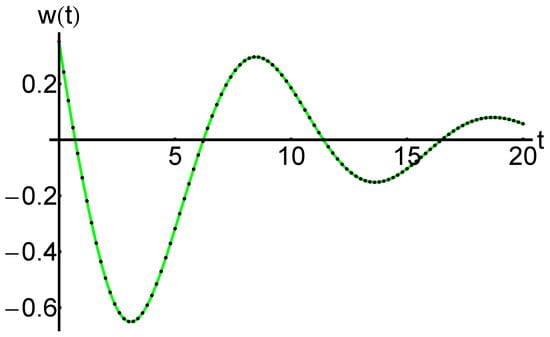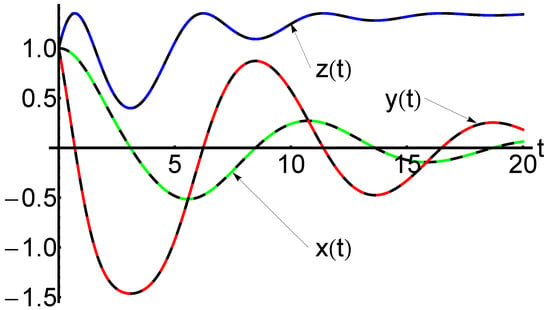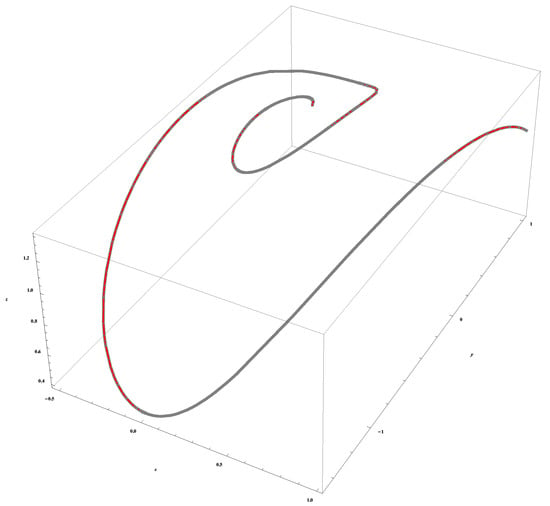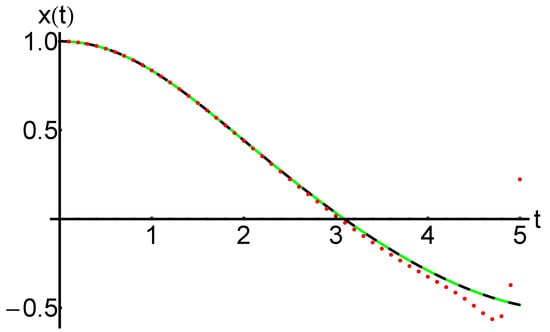Abstract
The aim of our work is to obtain the analytic solutions for a new nonlinear anharmonic oscillator by means of the Optimal Homotopy Asymptotic Method (OHAM), using only one iteration. The accuracy of the obtained results comes from the comparison with the corresponding numerical ones for specified physical parameters. Moreover, the OHAM method has a greater degree of flexibility than an iterative method as is presented in this paper. Based on these results, the analytically solutions of the Chen system were obtained for a special case (just one analytic first integral). The chaotic behaviors were excluded here. The provided solutions are usefully for many engineering applications.
Keywords:
ordinary differential equations; solution of equations; Chen system; anharmonic oscillator; approximate solution MSC:
34C14; 37M05; 37M99; 37N99
1. Introduction
Many applications in electrical engineering, medicine, outdoor weather control application, secure communication techniques, and so on are based by the study of chaotic dynamic systems. Therefore, many techniques have been developed to study the perturbation of this simple periodic motion.
Even if the one dimensional harmonic oscillator potential is a suitable model for a series of physical problems, in many cases the concordance with the experimental values is not sufficient. A typical example is the diatomic molecule whose motions, especially vibrations, cannot be described sufficiently by using the one dimensional harmonic oscillator potential. Among many models of anharmonic potentials a privileged position for the potential energy of a diatomic molecule is occupied by the Morse oscillator potential due to its applications in quantum mechanics [1] to diatomic or polyatomic molecules, spectroscopy, and so on. This is a convenient model because it explicitly includes the effects of bond breaking, as well as the existence of unbound states, the anharmonicity of real bonds and bond dissociation. A modified version of anharmonic potential is used in different applications in nonlinear dynamical systems to solve the inverse scatting problem to derive so called soliton solutions [2].
Recently, He et al. [3] adopted a generalized Duffing oscillator using the homotopy perturbation method (HPM). Bel et al. [4] analyzed the synchronization and stability of coupled driven-damped Helmholtz-Duffing oscillators in bi-stability regimes. Synchronization of a nonlinear oscillator was explored by Vieira et al. [5]. Mariano et al. [6] considered a general class of nonlinear dynamical systems with memory. Furthermore, nonlinear oscillators equipped with fast varying periodic time delay feedback were developed by Liu et al. [7] using an analytical criterion. The mathematical techniques as periodic perturbations, stability, chaotic and asymptotic behaviors, and geometrical properties were developed in [8,9,10,11,12,13,14,15,16,17,18,19].
The Chen system [20] proposed in 1999, appears in a variety of studies, such as: Toda Lattice [21], Kowalevski top dynamics [22], Lotka–Volterra system [23], the battery model [24], Lagrange system [25], and others [26].
The relevance of the Chen chaotic system results from several approaches. For instance, an output feedback control algorithm for a single-input single-output variant was proposed in [27], the influence of the time delay was investigated in [28] showing that the single-scroll attractor is indeed chaotic, the global boundedness was explored in [29] using a suitable Lyapunov function, the equilibrium point stabilization problem by employing a simple linear feedback controller was discusses in [30], and others [31,32,33,34,35,36,37,38,39].
The aim of this work is to obtain the approximate closed-form solutions of the Chen system for a special case: just one analytic first integral known. For this case the Chen system could be reduced to an anharmonic oscillator which characterizes the behaviour of more physical systems of interest.
This paper is organized as follows. We focus on the analytical approaches of the approximate closed-form solutions for a special case of the Chen chaotic system in Section 2. In Section 3 we firstly proposed the differential equation which describes the nonlinear anharmonic oscillator. The OHAM method developed in [40,41,42] is applied for obtaining an approximate analytic solutions. Here, the study of the Chen chaotic system is reduced to a nonlinear anharmonic oscillator. Section 4 is devoted to the numerical simulations. There is an excellent agreement between the analytic approximate solution and the corresponding numerical solution which proved the validity of all obtained results. The last Section 5 is dedicated to some concluding remarks.
2. Approximate Closed-Form Solutions to the Chen’s System
The Chen system was analytically solved by mathematical techniques as the multistage homotopy–perturbation method in [33], the multistage homotopy analysis method [34], the differential transformation method (DTM) [36], the Adomian decomposition method (ADM), [37], the mechanical analysis [43], and the geometrical frame [44].
The Chen’s system has the form:
where are real parameters. The system is chaotic when ([45]).
Remark 1.
- (a)
- If and the system (1) has the Hamilton–Poisson realization. The functional is the Hamiltonian and the is functionally independent Casimir. Thus, the exact solution is written as an intersection between the surfaces and .
- (b)
- For , the Hamiltonian function is , but finding the Casimir functions remains an open problem. Therefore, it is impossible to write the exact solution as an intersection between the surfaces and .
- (c)
- Otherwise, the Chen’s system is chaotic.
In the following we focus just on the case .
The system (1) becomes:
Remark 2.
The considered system admits a symmetry with respect to - axis, for .
Equation (2) identically satisfies, and Equation (2) yields:
which describes the a nonlinear anharmonic oscillator presented in details in the following section.
For the unknown function w the initial conditions are:
3. Application to the Nonlinear Anharmonic Oscillator
The nonlinear anharmonic oscillator given by Equation (5) in our approach could be described by the following equation:
subject to the initial conditions:
with , , , given real numbers.
Taking into account of the initial conditions given by Equation (9), the approximate solutions, denoted , of Equation (8) are deducted for the unknown function .
By using OHAM method (Marinca and Herisanu [40,41,42], for more details) to Equations (8) and (9) an analytic approximate solution, denoted , is obtained using only one iteration.
For an embedding parameter , the first-order approximate solution for nonlinear differential problem given by Equations (8) and (9) could be written as:
with the initial approximation and the first approximation depending on the variable t and the several unknown optimal parameters , , , …, , with an arbitrary integer number.
The homotopic relation is given by [41]:
where the nonlinear operator has the form
and is a known auxiliary function. Taking into account Equations (10) and (12) the homotopic relation from Equation (11) becomes:
where is an auxiliary convergence-control function depending of the variable t and of the parameters , , …, . The linear operator has the form:
where are unknown parameters at this moment.
Therefore, the form of the nonlinear operator corresponding to the unknown function w is obtained from Equation (8) by:
The deformations problems are obtained by identifying the coefficients and , respectively.
Some possibilities to choose the auxiliary function could be:
where , or
or
or
and so on.
3.1. The Zeroth-Order Deformation Problem
3.2. The First-Order Deformation Problem
The nonlinear operator Equation (15) for the initial approximation given by Equation (18), using Equation (15) becomes:
where
It depends on the elementary functions , , , , , . For , from Equation (13) the first-order deformation problem becomes:
3.3. The First-Order Analytical Approximate Solution
4. Numerical Simulation
In order to demonstrate the accuracy and validity of the OHAM technique, a comparison between our approximate solutions with corresponding numerical results obtained via the fourth-order Runge–Kutta method is highlighted.
We consider the initial value problem given by (2) with initial conditions , , , and . The convergence-control parameters K, , , are optimally determined by means of the least-square method.
Table 1, Table 2, Table 3 and Table 4 emphasizes the accuracy of the OHAM technique by comparing the approximate analytic solutions , , , and , presented above with the corresponding numerical integration values (via the fourth-order Runge–Kutta method). These comparisons show the effectiveness, reliability, applicability, and efficiency of the OHAM.
Table 1.
Comparison between the analytical approximate solution of Equation (22) and the corresponding numerical values for different values of the index number .
Table 2.
Comparison between the analytic closed-form approximate solution given by Equation (7) and corresponding numerical solution; the relative errors .
Table 3.
Comparison between the analytic closed-form approximate solution given by Equation (7) and corresponding numerical solution; the relative errors .
Table 4.
Comparison between the analytic closed-form approximate solution given by Equation (7) and corresponding numerical solution; the relative errors .
All the convergence-control parameters, corresponding to the intervals are presented in Appendix A.
Figure 1, Figure 2 and Figure 3 present the comparisons between the analytical approximate solutions given by OHAM and numerical results provided by Runge–Kutta fourth steps integrator, for initial conditions , , , and for . From these figures it follows that the behavior of the analytical approximate solutions and Runge–Kutta fourth steps integrator’s results are quite the same.
Figure 1.
Comparison between the analytical approximate solution of Equation (22) and the corresponding numerical solution: numerical solution (with lines) and OHAM solution (dashing lines), respectively.
Figure 2.
Comparison between the approximate closed-form solutions , , of the Chen system given by Equation (7) and corresponding numerical solution: numerical solution (with lines) and OHAM solution (dashing lines), respectively.
Figure 3.
The parametric curve is the 3D-trajectory of the Chen system: numerical solution (with lines) and OHAM solution (dashing lines), respectively.
The corresponding relative errors are presented in detail in Appendix A.
Below we highlight the advantages of the OHAM method by comparison with an iterative method developed in [46]. By integration of the system (2) over the interval , the following relations are obtained:
The iterative algorithm is the following:
With the iterative method, the solutions of system (2) have the form:
For the case using seven iterations, with the initial conditions , , and the constants , , taking into account of the algorithm (24), the iterative solutions become:
A comparison between approximate closed-form solutions , , and the corresponding iterative solutions , , given in (25) is shown in the Appendix A both graphically in Figure 4 and tabularly in Table 5, respectively.
Figure 4.
Comparison between the approximate closed-form solution , of the Chen system given by Equation (7), corresponding numerical solution and the iterative solution given by Equation (25): numerical solution (with lines), OHAM solution (dashing lines), and iterative solution (dotted curve), respectively.
This comparison shows the precision and efficiency of the OHAM method (using just one iteration) against to the iterative method described in [46] (using seven iterations).
5. Conclusions
For a special case of the Chen system (just one analytic first integral) is shown that this system could be reduced to a nonlinear anharmonic oscillator. An analytic approximate solution for the anharmonic oscillator problem was been obtained by means of the Optimal Homotopy Asymptotic Method. The numerical outcomes contribute to a better knowledge of the accuracy and validity of the OHAM technique. The flexibility of this method results from the comparison with the corresponding iterative procedure. The results of our present study are useful in understanding of the behavior for the dynamical systems as complete synchronization or optimization of nonlinear system performance.
Author Contributions
Conceptualization, N.P.; Data curation, R.-D.E. and N.P.; Formal analysis, N.P.; Investigation, R.-D.E. and N.P.; Methodology, R.-D.E.; Software, R.-D.E.; Supervision, N.P.; Validation, R.-D.E. and N.P.; Visualization, R.-D.E. and N.P.; Writing—original draft, R.-D.E. and N.P. All authors have read and agreed to the published version of the manuscript.
Funding
This research received no external funding.
Institutional Review Board Statement
Not applicable.
Informed Consent Statement
Not applicable.
Data Availability Statement
Not applicable.
Conflicts of Interest
The authors declare no conflict of interest.
Appendix A
In the following we will present just the values of the convergence-control parameters that appear in Equation (22); for , the initial conditions are , , , and different values of the index number .
Example A1.
:
Example A2.
:
Example A3.
:
Example A4.
:
References
- Popov, D.; Dong, S.; Pop, N.; Sajfert, V.; Simon, S. Construction of the Barut–Girardello quasi coherent states for the Morse potential. Ann. Phys. 2013, 339, 122–134. [Google Scholar]
- Gupta, V.P. Principles and Applications of Quantum Chemistry; Academic Press: Cambridge, MA, USA, 2016; pp. 1–46. [Google Scholar]
- He, J.; Jiao, M.; Gepreel, K.A.; Khan, Y. Homotopy perturbation method for strongly nonlinear oscillators. Math. Comput. Simul. 2023, 204, 243–258. [Google Scholar]
- Bel, G.; Alexandrov, B.S.; Bishop, A.R.; Rasmussen, K. Patterns and stability of coupled multi-stable nonlinear oscillators. Chaos Solitons Fractals Interdiscip. 2023, 166, 112999. [Google Scholar]
- Vieira, R.; Martins, W.S.; Barreiro, S.; de Oliveira, R.A.; Chevrollier, M.; Oria, M. Synchronization of a nonlinear oscillator with a sum signal from equivalent oscillators. Chaos Solitons Fractals 2021, 153, 111581. [Google Scholar]
- Mariano, P.M.; Spadini, M. Periodic solutions to perturbed nonlinear oscillators with memory. Physica D 2023, 445, 133635. [Google Scholar]
- Liu, Q.X.; Liu, J.K.; Chen, Y.M. An analytical criterion for alternate stability switches in nonlinear oscillators with varying time delay. Int. J.-Non-Linear Mech. 2020, 126, 103563. [Google Scholar]
- Bibikov, Y.N.; Savel’eva, A.G. Periodic Perturbations of a Nonlinear Oscillator. Differ. Equ. 2016, 52, 405–412. [Google Scholar]
- Kaparulin, D.S.; Lyakhovich, S.L. On the stability of a nonlinear oscillator with higher derivatives. Russ. Phys. J. 2015, 57, 1561–1565. [Google Scholar]
- Pei, Q.-Y.; Li, L. Chaotic behavior of a nonlinear oscillator. Appl. Math. Mech. 1993, 14, 395–405. [Google Scholar] [CrossRef]
- Ginoux, J.M.; Rossetto, B. Differential geometry and mechanics: Applications to chaotic dynamical systems. Int. J. Bifurcat. Chaos 2006, 16, 887. [Google Scholar]
- Hernández-Bermejo, B.; Fairen, V. Simple evaluation of Casimirs invariants in finite dimensional Poisson systems. Phys. Lett. A 1998, 241, 148–154. [Google Scholar]
- Kahan, W. Unconventional numerical methods for trajectory calculation. Unpubl. Lect. Notes 1993, 1, 13. [Google Scholar]
- Pop, C.; Petrisor, C.; Bala, D. Hamilton-Poisson Realizations for the Lü System. Math. Probl. Eng. 2011, 2011, 842325. [Google Scholar] [CrossRef]
- Ariesanu, C.P. Numerical integration and Stability Problems in the Study of Lorenz System. Acta Tech. Napoc. 2011, 54, 333–339. [Google Scholar]
- Puta, M. Hamiltonian Systems and Geometric Quantization. Mathematics and Its Applications; Springer: Berlin/Heidelberg, Germany, 1993; Volume 260. [Google Scholar]
- Tudoran, R.M.; Aron, A.; Nicoara, S. On a Hamiltonian Version of the Rikitake System. SIAM J. Appl. Dyn. Syst. 2010, 8, 454–479. [Google Scholar]
- Anakira, N.R.; Alomari, A.K.; Jameel, A.; Hashim, I. Multistage optimal homotopy asymptotic method for solving initial-value problems. J. Nonlinear Sci. App. 2016, 9, 1826–1843. [Google Scholar]
- Khatibzadeh, H. Asymptotic Behavior of a Discrete Nonlinear Oscillator with Damping Dynamical System. Adv. Differ. Equ. 2011, 2011, 867136. [Google Scholar] [CrossRef]
- Chen, G.; Ueta, T. Yet another chaotic attractor. Int. J. Bifurcat. Chaos 1999, 9, 1465–1466. [Google Scholar]
- Daminou, P.A. Multiple Hamiltonian structures for Toda systems of type A-B-C. Regul. Chaotic Dyn. 2000, 5, 17–32. [Google Scholar]
- Aron, A.; Puta, M. Stability, periodic solutions and numerical integration in the Kowalevski top dynamics. Int. J. Geom. Methods M 2006, 3, 1323–1330. [Google Scholar]
- Pop, C.; Aron, A.; Galea, C.; Ciobanu, M.; Ivan, M. Some geometric aspects in the theory of Lotka-Volterra system. In Proceedings of the 11th WSEAS International Conference on Sustenability in Science Engineering, Timisoara, Romania, 27–29 May 2009; pp. 91–97. [Google Scholar]
- Aron, A.; Girban, G.; Kilyeni, S. A Geometric Approach of a Battery Mathematical Model for On-Line Energy Monitoring. In Proceedings of the 2011 IEEE EUROCON-International Conference on Computer as a Tool, Lisbon, Portugal, 27–29 April 2011. [Google Scholar]
- Puta, M.; Pop, C.; Danaiasa, C.; Hedrea, C. Some geometric aspects in the theory of Lagrange system. Tensor 2008, 69, 83–87. [Google Scholar]
- Gumral, H.; Nutku, Y. Poisson structure of dynamical systems with three degrees of freedom. AIP J. Math. Phys. 1993, 34, 5691–5721. [Google Scholar]
- Gonzalez, G.A.; Nielsen, C.; Bortoff, Z. Attractivity of Unstable Equilibria for a Controlled Chen System via Small Output Feedback. Chaos Solitons Fractals 2022, 164, 112642. [Google Scholar]
- Ren, H.-P.; Tian, K.; Grebogi, C. Topological horseshoe in a single-scroll Chen system with time delay. Chaos Solitons Fractals 2020, 132, 109593. [Google Scholar]
- Qin, W.-X.; Chen, G. On the boundedness of solutions of the Chen system. J. Math. Anal. Appl. 2007, 329, 445–451. [Google Scholar]
- Alvarez-Ramirez, J.; Cevantes, I.; Femat, R. An equilibrium point stabilization strategy for the Chen system. Phys. Lett. A 2004, 326, 234–242. [Google Scholar]
- Hu, H.; Liu, L.; Ding, N. Pseudorandom sequence generator based on the Chen chaotic system. Comput. Physics Commun. 2013, 184, 765–768. [Google Scholar]
- Cheng, Z. Anti–control of Hopf bifurcation for Chen’s system through washout filters. Neurocomputing 2010, 73, 3139–3146. [Google Scholar]
- Chowdhury, M.S.H.; Hashim, I. Application of multistage homotopy–perturbation method for the solutions of the Chen system. Nonlinear Anal. Real World Appl. 2009, 10, 381–391. [Google Scholar]
- Alomari, A.K.; Noorani, M.S.M.; Nazar, R. Adaptation of homotopy analysis method for the numeric–analytic solution of Chen system. Commun. Nonlinear Sci. Numer. Simulat. 2009, 14, 2336–2346. [Google Scholar]
- Liu, Y.; Zhu, J.; Ding, D. Adaptive synchronization of Chen chaotic system with uncertain parameters. J. China Univ. Posts Telecommun. 2007, 14, 103–105. [Google Scholar]
- Al-sawalha, M.M.; Noorani, M.S.M. A numeric–analytic method for approximating the chaotic Chen system. Chaos Solitons Fractals 2009, 42, 1784–1791. [Google Scholar]
- Noorani, M.S.M.; Hashim, I.; Ahmad, R.; Bakar, S.A.; Ismail, E.S.; Zakaria, A.M. Comparing numerical methods for the solutions of the Chen system. Chaos Solitons Fractals 2007, 32, 1296–1304. [Google Scholar]
- Park, J.H.; Lee, S.M.; Kwon, O.M. Dynamic controller design for exponential synchronization of Chen chaotic system. Phys. Lett. A 2007, 367, 271–275. [Google Scholar]
- Wang, Y.; Guan, Z.; Wang, H.O. Feedback and adaptive control for the synchronization of Chen system via a single variable. Phys. Lett. A 2003, 312, 34–40. [Google Scholar]
- Marinca, V.; Herisanu, N.; Bota, C.; Marinca, B. An optimal homotopy asymptotic method applied to the steady flow of a fourth grade fluid past a porous plate. Appl. Math. Lett. 2009, 22, 245–251. [Google Scholar]
- Marinca, V.; Herisanu, N. Nonlinear Dynamical Systems in Engineering; Springer: Berlin/Heidelberg, Germany, 2011. [Google Scholar]
- Marinca, V.; Herisanu, N. The Optimal Homotopy Asymptotic Method: Engineering Applications; Springer: Berlin/Heidelberg, Germany, 2015. [Google Scholar]
- Liang, X.; Qi, G. Mechanical analysis of Chen chaotic system. Chaos Solitons Fractals 2017, 98, 173–177. [Google Scholar]
- Ariesanu, C.P.; Petrisor, C. A geometric approach of the Chen’s system. IFAC Proc. Vol. 2012, 45, 288–292. [Google Scholar]
- Zhou, T.; Tang, Y.; Chen, G. Chen’s attractor exists. Int. J. Bifurcat. Chaos 2004, 14, 3167–3177. [Google Scholar]
- Daftardar-Gejji, V.; Jafari, H. An iterative method for solving nonlinear functional equations. J. Math. Anal. Appl. 2006, 316, 753–763. [Google Scholar]
Disclaimer/Publisher’s Note: The statements, opinions and data contained in all publications are solely those of the individual author(s) and contributor(s) and not of MDPI and/or the editor(s). MDPI and/or the editor(s) disclaim responsibility for any injury to people or property resulting from any ideas, methods, instructions or products referred to in the content. |
© 2023 by the authors. Licensee MDPI, Basel, Switzerland. This article is an open access article distributed under the terms and conditions of the Creative Commons Attribution (CC BY) license (https://creativecommons.org/licenses/by/4.0/).




